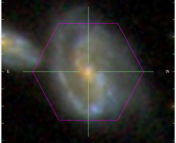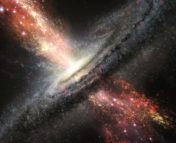Authors: John D. Silverman, Shenli Tang, Khee-Gan Lee, Tilman Hartwig, Andy Goulding, Michael A. Strauss et al.
First Author’s Institution: Kavli IPMU & Department of Astronomy, The University of Tokyo, Japan
Status: Accepted by ApJ. Open access on Arxiv.
Black hole power couples
The scales in the Universe are beyond our imagination. From the huge scale of galaxy superclusters, to the giant mass contained within dark matter halos, to the astonishing density of bodies like supermassive black holes (SMBHs), all are natural wonders evolving with cosmic time. Scientists believe that all these enormous structures grew from a much smaller scale, through processes like merging (Figure 1). Therefore, galaxy mergers are essential to better understand the evolutionary history of the most powerful and luminous objects in the Universe.

When two SMBHs collide into each other, the central region of the merger may ignite a long-lasting burst of light, which shines over one trillion (~1012) times brighter than the Sun. This pair of merging SMBHs, a luminous dual quasar, is among the most powerful and luminous objects in the Universe. In fact, due to their luminosity, scientists have found many of these “power couples”. However, most previous discoveries only contain dual quasars with relatively large separation. If the distance between the two rotating quasars is closer than 20 kpc (e.g., stage c in Figure 1), it is very challenging for scientists to separate them due to the instrumental limits of current telescopes. As a result, a dual SMBH can sometimes be misclassified as one single SMBH.
One way to solve this problem is to exploit the superb instrumental advantages of the Subaru telescope, used by the Hyper Suprime-Cam Subaru Strategic Program (HSC SSP). In today’s paper, the authors use optical imaging from the HSC along with spectroscopy to improve the identification of luminous dual quasars at close separation. By discovering more of these BH “power couples”, the authors are able to probe the growth of SMBHs across cosmic time.
Newly discovered dual quasars
HSC SSP observes a large area of the sky which includes over 34,000 quasars. In the optical imaging of all these quasars, the authors search for emission peaks in order to identify galaxy mergers with dual SMBHs. They fit the selected imaging to a model with two quasar components and one galaxy component. After removing the contamination of surrounding starlight from the data, the authors obtain a clean signal from the mergers alone.
Figure 2 shows an example of the observed dual quasars, where we can clearly see two separate quasars in one galaxy merger at close separation. In this particular case, the projected distance between two quasars is only 3.9 kpc!
Due to the effect of gravitational lensing, identifying two close point sources in optical imaging is only the first step to confirm the system as a dual quasar. One of the two point sources could be just a mirror image or a projection of the other source instead of a real quasar companion. Therefore, the authors need to check the spectroscopy of the system for further confirmation.
Figure 3 shows optical spectroscopy of the same dual quasar system in Figure 2. The authors notice two contributors with different velocities in their emission lines. This velocity offset suggests that the observed point sources are really two different quasars, not mirror images. Also, the velocity difference is very small. This only happens when two quasars are rotating in the same galaxy merger. Therefore, based on the optical spectroscopy, the authors confirm that this system they are looking at is indeed a luminous dual quasar!
How common are these BH power couples?
After successfully identifying three luminous dual quasar systems, the authors try to estimate how common these BH power couples are in the Universe. In other words, they compare the number of observed dual quasar systems to that of all detected quasars with correction factors, accounting for biases coming from observations and statistical assumptions. As a result, this dual fraction is low, around 0.26 ± 0.18%.
Furthermore, in HSC datasets, the age of the detected dual quasars can reach 12 billion years of cosmic time (as far as redshift z ~ 3.5). During this relatively long time period, simulations suggest that the dual fraction should decline over time. This is because, theoretically, galaxy mergers were more common at that time and so were dual quasars. However, the observational result is unexpected and contradicts the theory —— the authors find no evidence that this fraction evolves with time!
What does this mean? Given that the number of dual quasars remains fairly consistent in the observations, the formation of dual quasars may have nothing to do with different environments of the Universe at different epochs. These BH power couples might be simply products of random dynamic behaviors in galaxy mergers.
To further solve the contradiction between observations and simulations, it is necessary to observe larger datasets with the best instruments. Today’s paper shows that HSC is integral to the completion of this work, and will soon provide the world with many more dual quasars to learn from.




